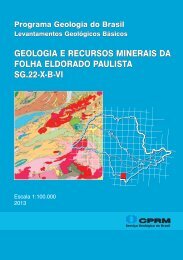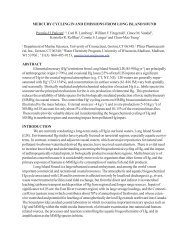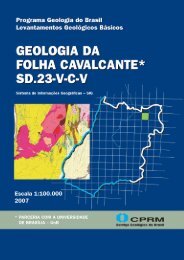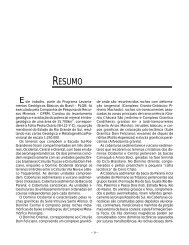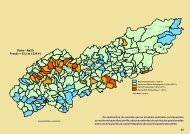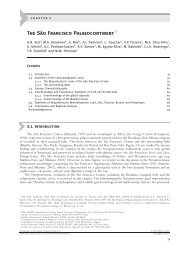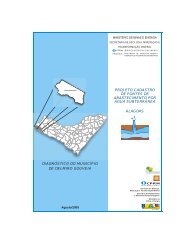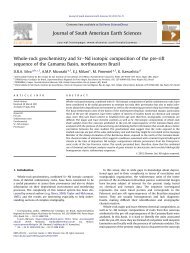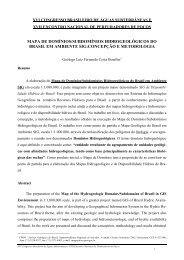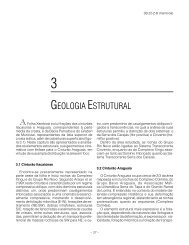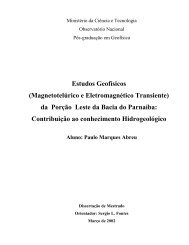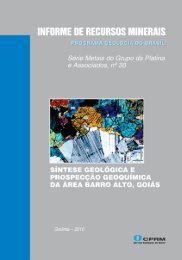Origin of the CO2-only fluid inclusions in the ... - CPRM
Origin of the CO2-only fluid inclusions in the ... - CPRM
Origin of the CO2-only fluid inclusions in the ... - CPRM
You also want an ePaper? Increase the reach of your titles
YUMPU automatically turns print PDFs into web optimized ePapers that Google loves.
36 E.L. Kle<strong>in</strong>, K. Fuzikawa / Ore Geology Reviews 37 (2010) 31–40<br />
Raman spectrographic studies were carried out at <strong>the</strong> Universidade<br />
Federal de M<strong>in</strong>as Gerais (Belo Horizonte, Brazil), with a laser-excited<br />
Dilor multichannel microprobe, us<strong>in</strong>g <strong>the</strong> 514.53 nm l<strong>in</strong>e <strong>of</strong> an argon<br />
laser. Integration time was 10 s with ten accumulations for each spectral<br />
l<strong>in</strong>e, and calibration was made with mercury light.<br />
6. Fluid <strong><strong>in</strong>clusions</strong><br />
6.1. Petrography, distribution and types<br />
Both high- and low-grade quartz show saccharoidal texture, with<br />
large, rounded to irregularly shaped crystals cemented by a mass <strong>of</strong> f<strong>in</strong>egra<strong>in</strong>ed<br />
quartz gra<strong>in</strong>s (Fig. 5). The larger gra<strong>in</strong>s show undulose ext<strong>in</strong>ction<br />
and m<strong>in</strong>or subgra<strong>in</strong> development. In <strong>the</strong> late quartz ve<strong>in</strong>lets, quartz forms<br />
aggregates <strong>of</strong> medium-gra<strong>in</strong>ed crystals with serrated contacts (Fig. 5E).<br />
Many crystals are stra<strong>in</strong>-free, recrystallized gra<strong>in</strong>s, lack<strong>in</strong>g <strong>fluid</strong> <strong><strong>in</strong>clusions</strong>.<br />
The distribution <strong>of</strong> <strong>the</strong> <strong>fluid</strong> <strong><strong>in</strong>clusions</strong> is similar <strong>in</strong> <strong>the</strong> three types<br />
<strong>of</strong> quartz. They occur dom<strong>in</strong>antly along narrow to large transgranular<br />
and <strong>in</strong>tragranular trails that term<strong>in</strong>ate aga<strong>in</strong>st gra<strong>in</strong> boundaries or<br />
with<strong>in</strong> <strong>in</strong>dividual crystals (Fig. 5). Isolated <strong><strong>in</strong>clusions</strong> and clusters <strong>of</strong><br />
randomly distributed <strong><strong>in</strong>clusions</strong> are also frequent. Some gra<strong>in</strong>s show<br />
clouds or swarms <strong>of</strong> tightly-spaced subparallel trails <strong>of</strong> <strong>fluid</strong> <strong><strong>in</strong>clusions</strong>.<br />
These textural relationships show that <strong>the</strong> <strong><strong>in</strong>clusions</strong> cannot<br />
all be def<strong>in</strong>ed as primary <strong><strong>in</strong>clusions</strong>, <strong>in</strong> <strong>the</strong> sense <strong>of</strong> Roedder (1984).<br />
Two different types <strong>of</strong> <strong>fluid</strong> <strong><strong>in</strong>clusions</strong> have been identified based on<br />
<strong>the</strong> number <strong>of</strong> phases and liquid to vapour ratios at room temperature<br />
(Fig. 5). Type 1 consists <strong>of</strong> one-phase vapour-rich <strong>fluid</strong> <strong><strong>in</strong>clusions</strong> that<br />
occur <strong>in</strong> <strong>the</strong> three types <strong>of</strong> quartz and is <strong>the</strong> unique type present <strong>in</strong> <strong>the</strong><br />
high- and low-grade quartz samples. The <strong><strong>in</strong>clusions</strong> <strong>of</strong> this type are<br />
generally dark, with negative crystal morphologies, mostly vary<strong>in</strong>g <strong>in</strong><br />
size between 5 and 15 µm.<br />
Type 2 comprises two-phase, liquid-rich <strong>fluid</strong> <strong><strong>in</strong>clusions</strong> that are<br />
restricted to <strong>the</strong> late quartz ve<strong>in</strong>let. Only seven measurable (N5µm)<br />
<strong>fluid</strong> <strong><strong>in</strong>clusions</strong> belong<strong>in</strong>g to this type have been recognized occurr<strong>in</strong>g <strong>in</strong><br />
two clusters <strong>in</strong> association with <strong>the</strong> Type 1. They consist <strong>of</strong> a dark<br />
gaseous bubble and a clear liquid phase, with a ra<strong>the</strong>r constant gas/liquid<br />
ratio <strong>of</strong> 0.25 to 0.40. Under cool<strong>in</strong>g, a new bubble nucleated <strong>in</strong> both types<br />
1 and 2 <strong>fluid</strong> <strong><strong>in</strong>clusions</strong>, allow<strong>in</strong>g <strong>the</strong>m to be def<strong>in</strong>ed as carbonic and<br />
aqueous-carbonic <strong><strong>in</strong>clusions</strong>, respectively.<br />
6.2. Micro<strong>the</strong>rmometric and micro-Raman results<br />
Dur<strong>in</strong>g <strong>the</strong> micro<strong>the</strong>rmometric work several runs have been<br />
undertaken down to <strong>the</strong> lowest limit <strong>of</strong> temperature <strong>of</strong> <strong>the</strong> heat<strong>in</strong>g–<br />
freez<strong>in</strong>g stage (∼180 °C), <strong>in</strong> order to detect <strong>the</strong> presence <strong>of</strong> CH4 and/or N2.<br />
However, all <strong><strong>in</strong>clusions</strong> froze between −100 and −120 °C, <strong>in</strong>dicat<strong>in</strong>g that<br />
<strong>the</strong>se compounds are not present <strong>in</strong> significant amounts.<br />
After heat<strong>in</strong>g from <strong>the</strong>se low temperatures, <strong>the</strong> melt<strong>in</strong>g <strong>of</strong> CO 2<br />
(Tm<strong>CO2</strong>) <strong>in</strong> both carbonic and aqueous-carbonic types occurred <strong>in</strong> a relatively<br />
narrow <strong>in</strong>terval, <strong>in</strong> all types <strong>of</strong> quartz, between −56.6 and −<br />
58.2 °C, with a sharp peak be<strong>in</strong>g observed at −57.4 °C (Fig. 6A), <strong>in</strong>dicat<strong>in</strong>g<br />
<strong>the</strong>dom<strong>in</strong>ance<strong>of</strong>CO 2 and <strong>the</strong> presence <strong>of</strong> o<strong>the</strong>r gases <strong>in</strong> subord<strong>in</strong>ate<br />
amounts. In fact, micro-Raman spectroscopic analysis <strong>of</strong> a few <strong>fluid</strong> <strong><strong>in</strong>clusions</strong><br />
identified <strong>only</strong> traces <strong>of</strong> CH 4 and C 2H 6 (ethane) and up to 2 mol.%<br />
<strong>of</strong> N2 <strong>in</strong> <strong><strong>in</strong>clusions</strong> from <strong>the</strong> high-grade quartz.<br />
Homogenisation <strong>of</strong> <strong>the</strong> carbonic phase (T hCO 2) <strong>of</strong> <strong>the</strong> type 1 <strong><strong>in</strong>clusions</strong><br />
occurred to liquid <strong>in</strong> a wide range <strong>of</strong> temperatures, from −28.5 to +<br />
29.9 °C, with most <strong>of</strong> <strong>the</strong> values cluster<strong>in</strong>g between +2 and +10 °C.<br />
Fig. 5. Photomicrographs show<strong>in</strong>g types and distribution <strong>of</strong> <strong>fluid</strong> <strong><strong>in</strong>clusions</strong> <strong>in</strong> ve<strong>in</strong>s from <strong>the</strong> Carará gold deposit. (A) Quartz crystal <strong>of</strong> <strong>the</strong> high-grade quartz ve<strong>in</strong> with clouds and<br />
trails <strong>of</strong> one-phase carbonic <strong>fluid</strong> <strong><strong>in</strong>clusions</strong>. (B) Detail <strong>of</strong> photograph A, show<strong>in</strong>g a planar array <strong>of</strong> carbonic <strong><strong>in</strong>clusions</strong> with negative crystal shape. (C) Quartz crystal <strong>of</strong> <strong>the</strong> low-grade<br />
quartz ve<strong>in</strong> with trails <strong>of</strong> one-phase carbonic <strong><strong>in</strong>clusions</strong>. (D) Detail <strong>of</strong> photograph C show<strong>in</strong>g planar arrays <strong>of</strong> carbonic <strong><strong>in</strong>clusions</strong> with negative crystal shape. (E) Barren late quartz<br />
ve<strong>in</strong>let crosscutt<strong>in</strong>g <strong>the</strong> host rock. (F) Detail <strong>of</strong> photograph E show<strong>in</strong>g a trail with a few two-phase aqueous-carbonic <strong><strong>in</strong>clusions</strong>.



